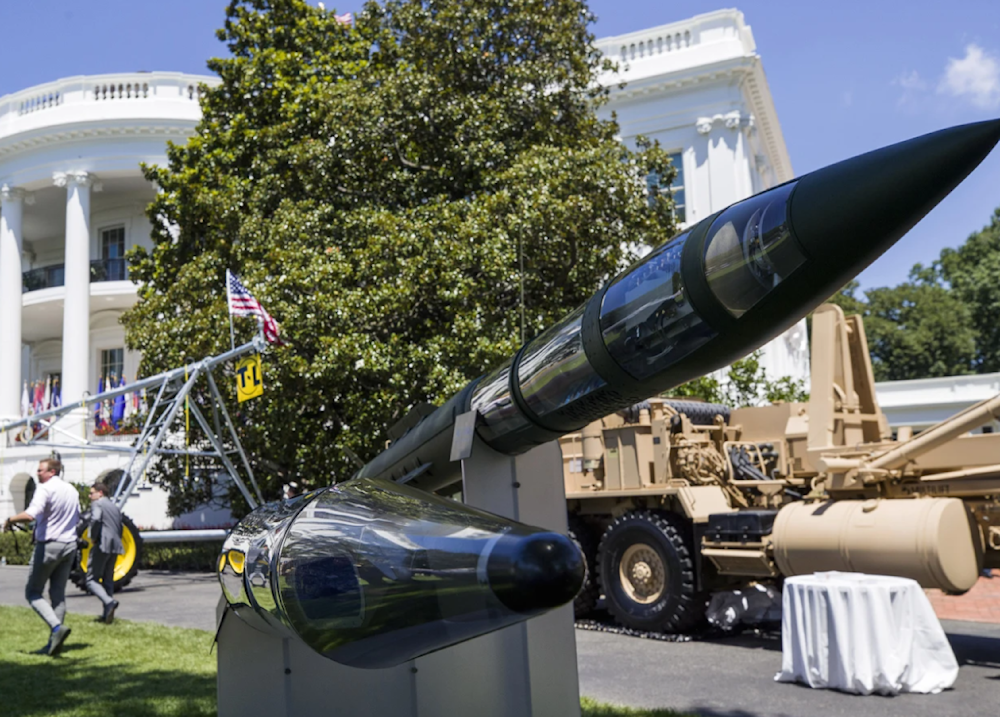Pentagon pushes to double missile production amid concerns over China
The Pentagon urges US missile makers to rapidly boost output as fears rise over weapons shortages amid fears of a potential conflict with China.
-

A Terminal High Altitude Area Defense (THAAD) anti-ballistic missile defense system is displayed during a Made in America showcase on the South Lawn of the White House on July 15, 2019, in Washington (AP)
The Pentagon is intensifying pressure on US missile manufacturers to significantly boost production of key munitions, citing concerns that current stockpiles would be insufficient in the event of a potential future conflict with China.
Amid growing strategic tensions in the Pacific, the Department of Defense has initiated an aggressive effort to double, or in some cases quadruple, output levels for 12 high-demand weapons systems. The initiative is being spearheaded by Deputy Defense Secretary Steve Feinberg through the newly formed Munitions Acceleration Council.
High-level meetings aim to accelerate missile assembly
The urgency of the program has been underscored by a series of high-level meetings between Pentagon officials and senior executives from leading US defense contractors. In June, a roundtable was convened at the Pentagon with attendance from Defense Secretary Pete Hegseth and Chairman of the Joint Chiefs of Staff Gen. Dan Caine. Participating companies included Lockheed Martin, Raytheon parent RTX, Anduril Industries, and key suppliers of rocket propellants and electronic components.
Pentagon spokesman Sean Parnell stated, “President Trump and Secretary Hegseth are exploring extraordinary avenues to expand our military might and accelerate the production of munitions... This effort has been a collaboration between defense industry leaders and senior Pentagon officials.”
Defense industry warns of cost, timeline changes
Despite the government’s push, some defense industry representatives have raised concerns about the feasibility of the Pentagon's aggressive goals. Missiles such as the Patriot interceptor often take years to assemble, and testing new suppliers for critical components can add months and substantial costs.
Although the Trump administration’s Big, Beautiful Bill, passed in July, authorized $25 billion in five-year funding for munitions, defense analysts warn that this will fall short, as meeting the Pentagon’s current objectives could require tens of billions more in investment.
“Companies don’t build these things on spec,” said Tom Karako of the Center for Strategic and International Studies. “There needs to be an expression of support with money. It can’t just be words.”
Contractors cautious without clear funding commitments
Major contractors, including Lockheed Martin and RTX, say they have taken steps to scale operations, adding workers, expanding floor space, and stockpiling critical parts. However, some remain hesitant to fully commit resources without guaranteed government contracts.
RTX Chairman Christopher Calio wrote in a July 3 letter to the Pentagon, saying, “Signaling the demand strength of these critical munitions to the supply base with Program of Record extensions... and funding to support is required.”
Trump administration’s $25bln bill not enough
Though the $25 billion funding package marks a significant increase, industry insiders argue that fulfilling the Pentagon’s expectations, particularly the doubling of missile production within two years, will require far more sustained investment and planning.
The Pentagon’s focus is on a dozen weapons systems deemed essential for a potential conflict with China. These include Patriot interceptors, Long Range Anti-Ship Missiles, Standard Missile-6, Precision Strike Missiles, and Joint Air-to-Surface Standoff Missiles.
The Patriot missile production line in particular has come under scrutiny, as Lockheed Martin struggles to meet demand driven by recent global conflicts.
Lockheed, RTX, Boeing, Northrop ramp up output
To meet these goals, the Army recently awarded Lockheed Martin nearly $10 billion to produce 2,000 PAC-3 missiles from 2024 to 2026. The Pentagon ultimately wants to quadruple that output annually.
Lockheed is considering further investments in its production line. Boeing, which supplies a critical seeker component, expanded its factory by 35,000 square feet and has hit record delivery levels.
Northrop Grumman has also committed $1 billion to increase the output of solid rocket motors, essential for several systems, and plans to nearly double production in the next four years.
The Pentagon is also conducting a deep review of its munitions supply chains. It is mapping critical suppliers and identifying single points of failure that could slow production. One such chokepoint is the Boeing-made seeker embedded in the Patriot missile’s nose.
Efforts are underway to secure secondary suppliers and encourage contractors to license production technologies to third-party manufacturers.
Ukraine, Iran conflicts expose weaknesses in US arsenal
The drive to ramp up missile production follows years of rising concern within the Pentagon over US readiness. Since Russia’s 2022 military operation in Ukraine, the US has depleted significant missile reserves, particularly high-value interceptors like the Patriot.
“The current conflict in Ukraine has been a wake-up call,” former Undersecretary of Defense Bill LaPlante said in 2023. “We’ve allowed production lines to go cold, watched as parts became obsolete and seen sub-tier suppliers consolidate or go out of business entirely.”
Recent events have only amplified those concerns. In June, the US fired hundreds of advanced missiles during a 12-day military escalation between "Israel" and Iran, further straining its missile stockpile.
The Pentagon’s urgent push to expand missile production capacity reflects deep concerns about the US military’s preparedness for a potential conflict with China. While major defense contractors have signaled willingness to scale up, serious challenges remain, including funding gaps, supply-chain bottlenecks, and production timelines.

 5 Min Read
5 Min Read








